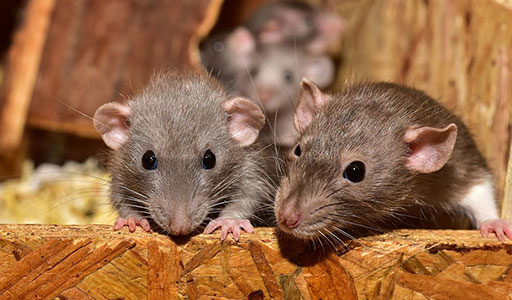Rodent Control in Fort Myers, FL
Do you need to get rid of rats? We can help!
Some Geographic Restrictions

Rat Control Strategies
Not only are rats the most common pest animal in the United States, but also they are one of the most destructive. In Fort Myers, the most common rats are the palm rat and the Norway rat.
Don’t waste your hard-earned money on DIY trapping methods that won’t solve your problem. Call in the team of experts at Trutech for rat removal and rat control services that an effective and permanent solution. Hiring a team of professionals from Trutech will take care of your problem in an environmentally sensitive way. Our specialists have the tools and knowledge necessary to prevent the spread of diseases from rats that enter your house or yard.
Trust Trutech to take care of all of your rat removal needs in the most thorough, humane, and environmentally cautious manner. Don’t wait until rats have invaded your home, garage, and yard to call in a professional team- Call Trutech and implement our environmentally sound rat control solutions and keep your home clean and safe for all of its invited inhabitants.
Rodent Control in Fort Myers

Rat Trapping
Trapping is the most effective method of rat control. The size of the infestation will determine the number of traps, the types of traps, and the rat bait to use. Infestation size also determines the process's length, which can range from a few days to weeks. With a large colony, other control measures, including tamper-resistant bait stations, may be required around the perimeter of your structure.

Rat Exclusion
Exclusion is the most effective, long-term rat control. If you successfully remove every rat in your home but do not implement exclusion and prevention techniques, your home is at risk for future rat activity. Rats can squeeze through a 1/4 inch size hole. Seal cracks and openings in building foundations and any openings for water pipes, electric wires, sewer pipes, drain spouts, and vents. Rats cam gnaw away materials like wood, caulk, plastic, and aluminum.

Remediation and Clean up
After removing the rodents, the wildlife service technician applies sanitization agents to ensure the area is clean and won't affect you or your family. Any traces of rat feces or urine can lead to unwanted consequences, including attracting more rodents and growing mold spores.
Rat Problems

Signs a Rat Infestation
When rats enter homes, they prefer to stay out of sight in undisturbed areas like attics, crawlspaces, and garages.
Identifying a rat infestation, however, is easy, especially as the rodents increase in number.
Rat Noises– Rats move around a lot and individuals should listen for the sounds of scurrying in attics, false ceilings, and wall voids. These noises intensify at nighttime, as rats are nocturnal and become most active after dusk.
Rat Droppings – Look for rat droppings around sources of food, like pantries, smudge marks on walls left by the greasy, oily fur of rats, and gnawing damage.
Rat Nests– residents may spot adult rats in sheltered locations such as storage boxes, seldom-used drawers, and stacks of firewood.

Dangers of Rat Infestation
Rats in the house can create serious problems for both people and property.
Rats can cause prolific damage from their constant gnawing. They will gnaw on any material in your home including wires, pipes, wood, and metal. Roof rats will create nests in your insulation.
Rats carry various diseases. Some of the most commonly transmitted maladies include leptospirosis, plague, salmonellosis, and tularemia. Rats can spread diseases from direct contact like bites, from their feces and urine, and from ectoparasites on their bodies.
Rats also get into and contaminate food intended for humans and pets. Due to the health risks created by rat infestations, professional pest control is often the best way to achieve complete rat removal safely and effectively.
Some Geographic Restrictions
Frequently Asked Questions
Exterminators use various methods to get rid of rodents, with rodenticides and rat traps typically being the first line of treatment. Each pest may require a different type of pesticide.
Wildlife control operators use various methods to eliminate and prevent pest activity. “Control” refers to how they manage each pest species using long-term solutions. The primary treatments are safe and humane traps, one-way valves, and exclusions. Wildlife control operators determine why pests are in your home.
Aptly named, rat-bite fever is transmitted through contact with the rodents’ saliva. This, along with Hantavirus, salmonellosis, E. coli poisoning, and leptospirosis, is one of the illnesses people can catch directly from rats. Ticks, fleas, and mites that live in the pests’ fur often ferry rat diseases to humans indirectly.
In addition to the plague, these parasites may carry Lyme disease and Rocky Mountain spotted fever. The pests’ droppings, dander, and fur can also trigger allergic reactions.
There is more than one DIY rat repellent, though none are completely effective.
Popular repellents include:
- Putting out mothballs
- Sprinkling cayenne pepper in gardens
- Enclosing plants with hardware cloth
There are several issues with these approaches. Mothballs only last a short time and can be toxic to pets and small children. The other two rat deterrents may show some results outdoors, but don’t address indoor pests.
Homeowners looking to control infestations are usually offered standard rodent traps such as snap, cage, and burrow entrance traps, as well as glue boards.
Do Rat Traps Work?
This control measure is surprisingly effective. Since the pests are drawn to strange objects in their surroundings, they’re extremely susceptible to traps.
Unfortunately, trapping is not a long-term solution to pack rat problems. Homeowners are better off targeting factors that attract rodents in the first place such as poorly stored food or breaches leading into homes.
Other Issues with Rat Traps
Though rat traps have a higher rate of success than other control methods, this doesn’t mean it’s the best way to get rid of infestations. These animals often host a number of disease-carrying parasites in their fur, which means getting too close can be a health risk.
Also, after
When rats enter homes, they prefer to stay out of sight in undisturbed areas. Identifying a rat infestation, however, is easy, especially as the rodents increase in number. Rats move around a lot and individuals should listen to the sounds of scurrying in attics, false ceilings, and wall voids. These noises intensify at nighttime, as rats are nocturnal and become most active after dusk. Additionally, homeowners should look for rat droppings around sources of food, like pantries, smudge marks on walls left by the greasy, oily fur of rats, and gnawing damage. Finally, residents may spot adult rats in sheltered locations such as storage boxes, seldom-used drawers, and stacks of firewood.
Homeowners may be alerted to the presence of rats in the attic by sounds, sights, and smells. Usually the most apparent signs of infestation are the scratching and scurrying sounds these rodents make. As rats are nocturnal, they are noisiest when individuals are settling in for a night of rest. Additionally, home residents may notice visual cues such as rat droppings, teeth marks in food containers, and even tracks. Finally, the musky smell of rat presence and malodorous collections of droppings and urine are sure indications of rat infestations in the attic.
To detect the presence of rats in walls, residents should remain alert for rat droppings around homes, oily smudge marks, and gnawed holes in walls and food containers. Droppings are long, cylindrical pellets typically dark brown in color that can be found wherever rats frequent.
Smudge marks appear as greasy patches on floors and walls as a result of the pests’ dirty fur rubbing up against a surface.
Finally, rats use their large front teeth to chew access holes into walls and gnaw open food containers. These openings are ragged around the edges and may only be as large as half an inch in diameter.
Since rats are primarily active at night, infestations usually go undetected for some time. However, knowing what rat signs to look for allows property owners to notice the presence of rats
under decks sooner. Telltale signs of rat infestations include scratching and squeaking noises, the presence and smell of urine and excrement, and remnants of nesting materials like ripped up insulation.
A clever way to detect the presence of rats under decks is to place newspaper over the openings. After a few days, if the paper is ripped or gone, property owners should assume they’re dealing with an infestation.


